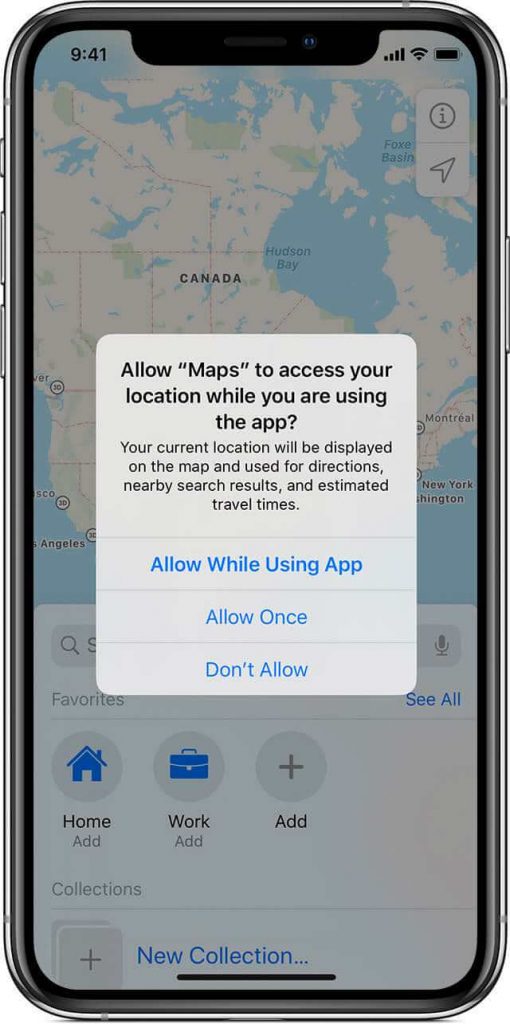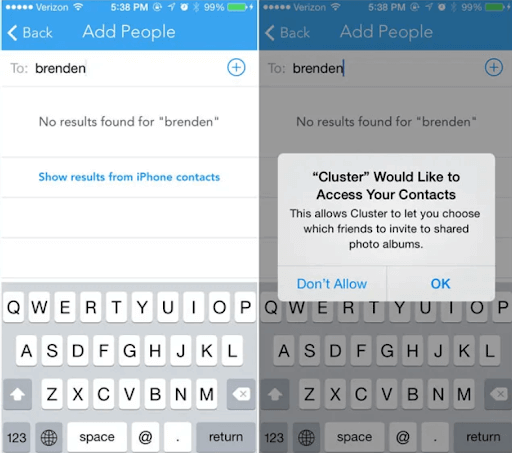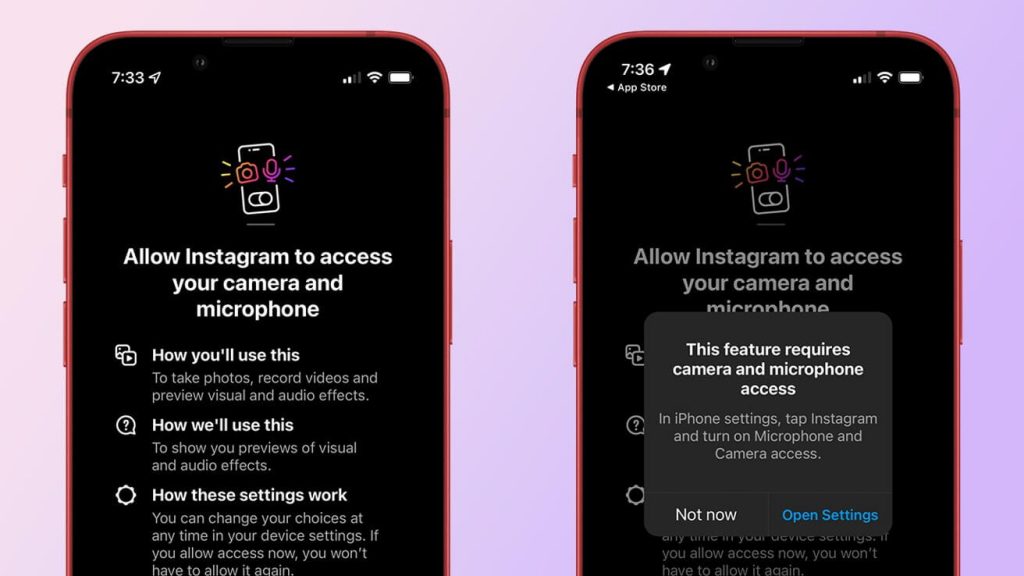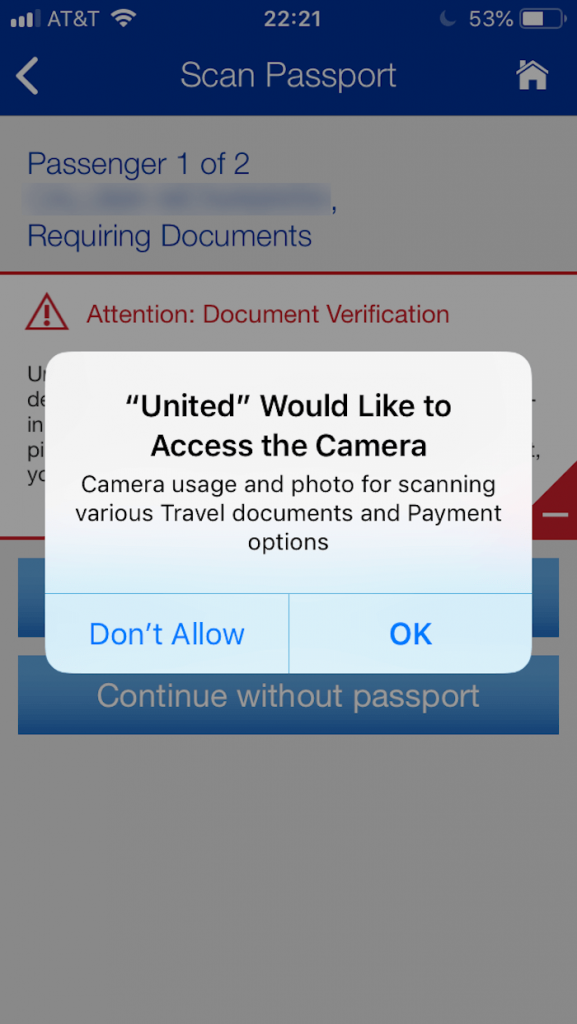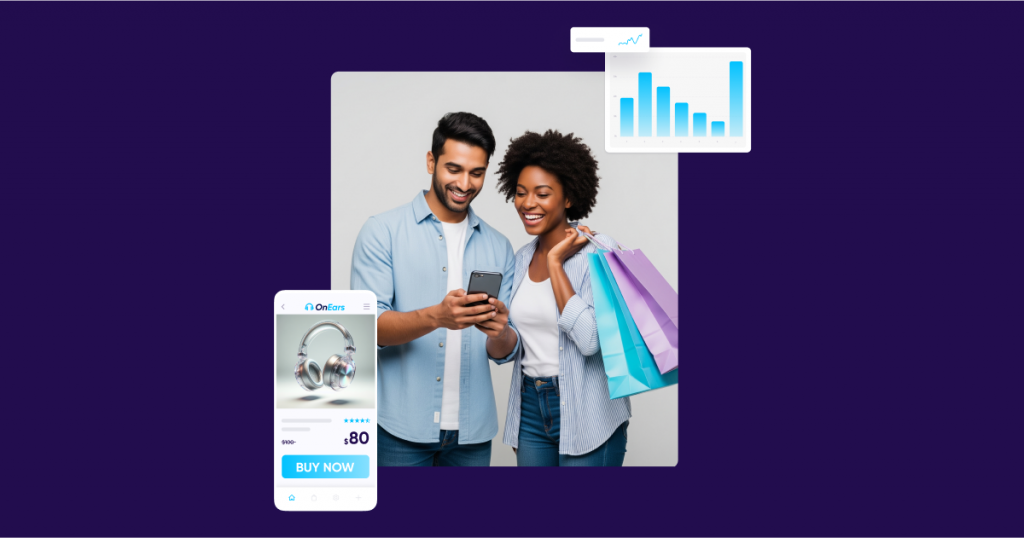
Chapter 1
Introduction
We’ve been hearing about how data is the new oil for years now. But just like you can’t put crude oil into your car without refining it, the same is true of data. It needs to be treated carefully to maximize value and as the landscape evolves, so do the challenges marketers face.
Specifically, sharing data between different companies is under heavy scrutiny making it harder and harder to get data from third parties. To help compensate for this signal loss, it is time to bring first-party data to new levels.
Welcome to the marketer’s guide to first-party data.
Here’s what we’ll cover
This guide has explored the critical aspects of first-party data for marketers, covering six key areas:
- Understanding first-party data: We’ll define first-party data, its types, and highlight how it differs from third-party data.
- The growing importance of first-party data: We’ll cover the changes in privacy regulations, platform policies, and user expectations and how they are reshaping the digital marketing landscape.
- Collecting first-party data: We’ll dive into the legal, platform, and user experience considerations including examples of user-friendly data collection.
- Keeping first-party data clean and actionable: We’ll provide strategies for maintaining data quality, including proper tooling, robust taxonomy, regular maintenance, and cross-team alignment.
- Using first-party data internally: We‘ll highlight how to use first-party data for product development, marketing optimization, and explore other cross-functional benefits such as customer relationship management.
Using first-party data externally: Finally, we’ll showcase how to use first-party data with external partners, including creating custom audiences for media activation and utilizing commerce media networks.

Chapter 2
So, what is first-party data?
Let’s start at the beginning. First-party data is information a company collects directly from its audience or customers, with their express consent. This data is directly owned by your brand and comes from various interactions across your owned digital experiences.
Key characteristics of first-party data:
- Collected directly from your audience
- Obtained with user consent (in rare cases, consent is not required)
- Reliable, accurate, and ethical
- Forges stronger connections with consumers
Types of first-party data
First-party data can be categorized into two main types:
Implicit data, which is information collected from user interactions, often happening in the background. Examples include app usage patterns, website visit frequency, feature engagement metrics, and in-app behavior.
Explicit data, (also known as “Zero-Party Data”) is information actively shared by users. This includes survey responses, poll participation, direct feedback, preference settings, and interests or goals selected during onboarding.
Together, implicit and explicit first-party data encompass a wide range of information, such as:
- Demographics
- Advertising IDs
- Purchase history
- Subscription details
- Email engagement metrics
- Social media followers
- App usage and behavior
- Website interactions
- User contact details e.g. phone number and email
- User feedback and preferences
First-party data vs. Third-party data
There are a few core ways that these two vital types of data differ from each other:
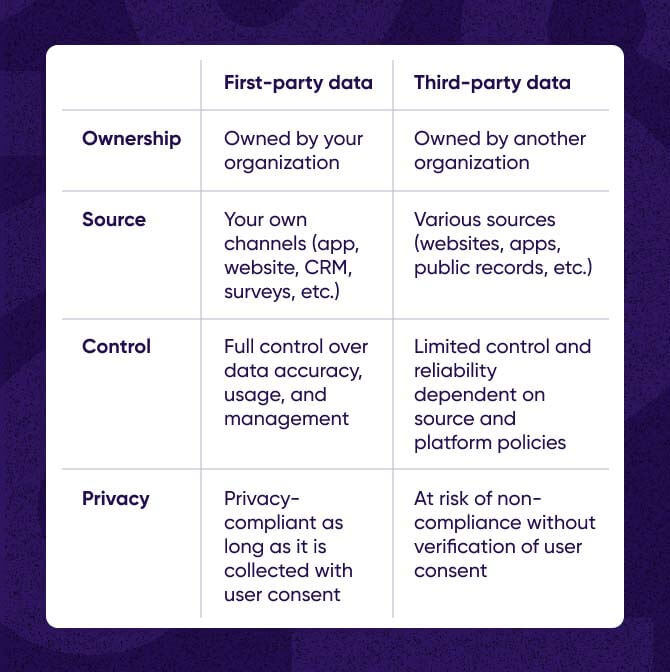
In a nutshell
On a general level, first-party data is more reliable than its counterpart, because you can verify how it was collected. First-party data can also fuel more accurate personalization and better targeting to reach high quality users. That fosters better direct relationships between your users and your brand. It’s also great for boosting performance according to Google; using first-party data for key marketing functions can lead to up to 2.9X revenue uplift and a 1.5X increase in cost savings. By focusing on first-party data, marketers can build stronger, more trusted relationships with their users while delivering more personalized and effective marketing campaigns.

Chapter 3
First-party data: The transition from luxury to necessity
Why first-party data matters now more than ever
A recent Deloitte x Google first-party data report found that 65% of developers are pivoting their data approaches, emphasizing trust-based collection of first-party data to stay ahead.
While first-party data has always been a valuable asset for app marketers, recent changes in the digital landscape have elevated its importance to unprecedented levels.
Understanding why first-party data is now more crucial than ever is essential for staying competitive in today’s changing digital landscape.
Partial loss of third-party signals
For years, marketers relied heavily on the ability to marry third-party data with their own data sources to help drive their campaign optimization, namely for targeting and retargeting the right users in acquisition and re-engagement campaigns, respectively.
However, recent changes have significantly restricted the ability to do so due to stricter privacy regulations (e.g., GDPR, CCPA), platform-level changes (e.g., Apple’s IDFA restrictions, browser cookie limitations), and increased user privacy awareness (more opt-outs, use of ad blockers and VPNs)
Shift in the data paradigm
Generally, the digital marketing landscape is moving away from open access to user data, emphasizing the need for consent-based, privacy-compliant data collection strategies.
Benefits of prioritizing first-party data
At the end of the day, the times are a-changin’ – but it’s not all doom and gloom. Renewed focus on first-party data offers several distinct advantages which make it worth the investment:
- Full ownership and control: Unlike third-party data, you have complete control over your first-party data, allowing for more flexible and strategic use.
- Accuracy and reliability: First-party data comes directly from your users, ensuring its accuracy and relevance to your specific audience.
- Relevance: It provides insights into your actual users’ behaviors, preferences, and interactions with your app and communications.
- Compliance: You can verify and ensure that your data collection and usage practices are fully compliant with relevant regulations.
- Fewer regulatory restrictions: Internal usage of first-party data typically faces fewer legal constraints compared to third-party data.
- Reduced external dependencies: Relying more on first-party data reduces your vulnerability to changes in external data sources or partners’ policies.
- Cost-effectiveness: Maximizing the use of first-party data can potentially reduce costs associated with acquiring external data.
Balancing first-party and third-party data
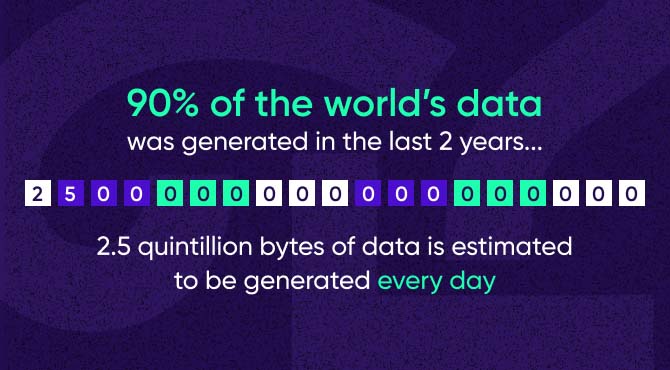
It’s important to note that the goal is not to replace third-party data, but rather to maximize the value of first-party data to compensate for the partial loss of external signals. Even with the complex, nuanced challenges of signal loss, third-party data still has a major role to play and is irreplaceable in some contexts, especially when it comes to media activation.
And let’s not forget that third-party data is data of a third party from the brand’s point of view, but it’s also that party’s first-party data. For example, data that Meta or Google or any other publisher has from its own users.
To strike the right balance, app marketers should:
- Optimize first-party data collection: An app is a great channel to use when implementing strategies to gather more high-quality first-party data through user interactions, surveys, and in-app behaviors.
- Improve and invest in data analysis: Develop robust analytics capabilities to extract meaningful insights from your first-party data – essentially turning the crude oil aka data into usable gas aka insights for campaigns.
- Maintain third-party data sources: While focusing on first-party data, maintain access to valuable third-party data where possible.
- Create a unified data strategy: Integrate first-party and third-party data sources using an MMP like AppsFlyer to create a comprehensive view of your users and market, and try to see as much of the picture as you can in one place.
Looking ahead to stay ahead
As the digital landscape continues to evolve, the importance of first-party data is likely to grow even further. Marketers who invest in robust first-party data strategies now will be better positioned to navigate future changes in privacy regulations and user expectations.
It’s always harder to play catch up and the earlier you start, the better. Don’t allow yourself to be caught off guard by any surprises that can damage your team’s ability to execute their campaigns.

Chapter 4
How to collect first-party data: legal, platform, and UX considerations
Collecting first-party data is crucial for marketers, but it must be done properly, considering legal requirements, platform restrictions, and user experience. Let’s talk through the key considerations and best practices for collecting first-party data.
Legal considerations
Most data collection requires user consent, with only a few exceptions (e.g., legal obligations, public interest, or fully anonymized data like through SKAdNetwork). App marketers must navigate a complex landscape of privacy regulations, including:
- GDPR in Europe
- CCPA in California
- LGPD in Brazil
- PIPEDA & Law 25 in Canada
While specific requirements may vary, some general principles apply broadly:
- Obtain explicit consent: Get clear, freely given consent from users. Avoid incentivizing consent, as this may breach the law.
- Non-discrimination: Don’t discriminate against users exercising their privacy rights (e.g., by offering different pricing).
- Granular consent: Allow users to consent to specific data uses rather than bundling all consent together.
- Transparency: Clearly state the purpose of data collection, how it will be used, and if it will be shared with third parties.
- Simple language: Use concise, easy-to-understand language instead of lengthy legal jargon.
- User control: Provide users with ways to access, view, opt-out, and delete their data.
- Data security: Implement robust security measures for data storage and report any breaches promptly.
There’s a lot to consider and as a marketer it’s important to be aware of it. However, your main action item is to involve your Data Protection Officer and other members of your legal team early and let them lead the collaboration here to maintain 100% compliance with confidence.
Bonus tip: Consent Management Platforms (CMPs)
If you are looking for tools to navigate the complex and evolving landscape of privacy regulations, you may want to consider Consent Management Platforms (CMPs).
These platforms provide out-of-the-box solutions for requesting consent in compliance with various legislations. We’ll take a closer look at these in the next chapter of this guide.
Platform restrictions
In addition to legal requirements, app marketers must comply with platform-specific restrictions. Some data requires explicit user permissions to access, including location services, contact list access, camera/microphone access, and advertising ID on iOS (IDFA), among others.
Developers need to be aware of these platform-specific requirements and implement the necessary permission requests in their apps. While many platforms will have similar requirements, each one is unique and should be treated as such.
In-app user experience (UX) considerations
Collecting data properly isn’t just about legal compliance; it’s also about creating a positive user experience to optimize consent rates. While every app is different these high-level guardrails should apply:
- User-friendly design: Create appealing designs and clear copy to explain how data collection benefits the user.
- Timing matters: Ask for permissions at the right moment to provide context and improve understanding.
- Gradual requests: Delay some permission requests until necessary to avoid overwhelming users during the first-time experience.
- Clear explanations: Provide context for why certain permissions are needed, we’ll cover some great examples of this below.
- Pre-prompts: Consider using explanation screens before the actual permission request to provide context and potentially improve opt-in rates.
Examples and best practices
To illustrate some of the above, check out these examples of popular permissions to request and how the company executes them:
Location services
Let’s take a look at TripAdvisor, a travel app that wants to provide deals and tips for the locations near you. They explain how location data improves your app functionality, and use a warm, branded pre-prompt to secure consent which triggers the official prompt from the device.
In contrast, navigation apps don’t need to explain why they need this permission because the use of location services is more obvious to the user – you can’t navigate without location services. The bottom line is that the timing and intent of the user can really influence how easy or difficult it is to get consent for permissions.
Contact list access
Just like location services, you’ll want to explain how this benefits app functionality and it is often a good idea to do that in context, like this example from Cluster – a photo sharing app. By adding in the context, and even an image of the permission request, it sets the stage for user consent. They also give the option to enter it manually which helps them avoid prompting for permission if they know it will be refused.
Cluster even doubles down on this approach by offering another request when the painful functionality is felt. Remember, timing is important. Even someone who may have refused at first might be convinced to opt-in now.
Camera access
In many apps, especially in social media, the reason for requesting camera access will be pretty straightforward. That doesn’t stop photo-giant Instagram from detailing their intentions, underscoring how important these details are even when it is obvious.
But what if it’s your airline app? United does a great job of explaining the exact reason they need the camera permission at the contextually relevant time. They don’t even need an extra pre-prompt for it because the natural course of action taken by the user is the prompt.
ATT consent
Every marketer with an app is all too familiar with this critical permission and it’s hard to find the perfect example because every flow is different. Some apps use pre-prompts to explain the benefits of allowing tracking before showing the official ATT prompt, while others find success with a more direct approach, going straight for the ask with no context at all. Test different approaches with your audience.
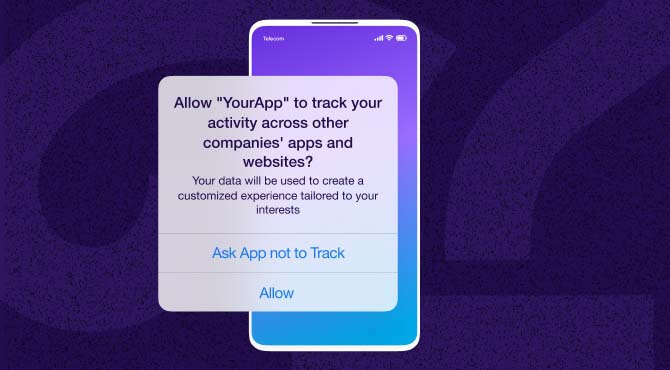
Variations by app category
To expand on the last point about ATT consent, It’s important to note that optimal approaches for any permission request can vary significantly by app category, as you may have noticed in some of the examples above:
- Health, dating, or finance apps may require more detailed explanations and assurances about data privacy.
- Games might benefit from a more direct approach, sometimes asking for permissions upfront without extensive pre-prompts.
Key takeaways to collect with care:
- Legal compliance: Ensure your data collection practices adhere to relevant privacy regulations.
- Platform adherence: Follow platform-specific guidelines for requesting permissions.
- User-centric approach: Design your data collection process with the user experience in mind.
- Transparency and timing: Clearly communicate the benefits and uses of the data you’re collecting and try to ask for permissions when it is relevant..
- Flexibility: Be prepared to adapt your approach based on your app category and user feedback.

Chapter 5
Keeping first-party data clean and actionable
Collecting first-party data is just the beginning. To truly harness its power, app marketers must ensure that the data is clean, well-organized, and actionable. Otherwise it is practically useless. This section will explore key strategies and considerations for maximizing the value of your first-party data.
The importance of clean and actionable data
Many brands collect vast amounts of data but struggle to take action because it’s not accessible or usable. According to Google, more than 60% of brands report issues linking technologies together. If there’s valuable insight about user behavior from a product analytics tool that remains siloed there – it’ll never get to the developers building the app or the marketing team who’s advertising it.
Clean, actionable data is crucial for making informed decisions, personalizing user experiences, optimizing marketing campaigns, and improving app performance and features.
5 strategies to keep data clean and actionable
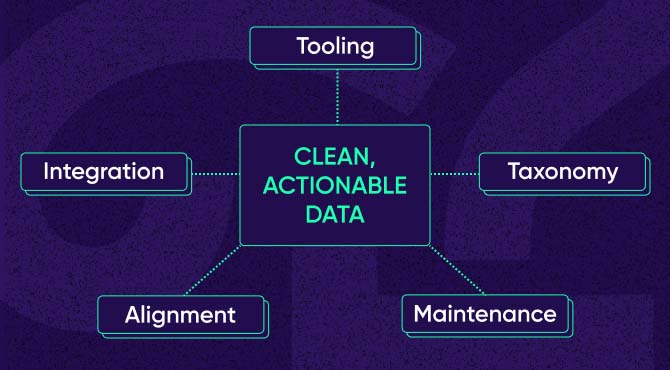
1. Implement proper tooling
Selecting the right tools is crucial for managing your first-party data effectively.
Consider:
- Product Analytics Tools: (e.g., Amplitude, Mixpanel)
- CRM/Lifecycle Tools: (e.g., Braze, Clevertap)
- Mobile Measurement Partners (MMPs): (e.g., AppsFlyer)
Of course, we can’t forget Customer Data Platforms (CDPs): (e.g., Segment, mParticle) for larger organizations to unify data across different sources and outputs such as the various tools listed above.
Choose tools that align with your long-term goals to avoid data loss or duplication during migrations.
2. Develop a robust taxonomy
A well-structured taxonomy or naming convention is critical for maintaining consistent, clean data. It’s how you ensure data consistency across teams, prevent data duplication, and facilitate easier analysis and reporting.
Here are some best practices for developing a taxonomy:
- Create a unified document listing all events, parameters, and user attributes
- Define clear naming conventions for events and properties
- Include examples for each data point to ensure clarity
- Track the state of implementation across platforms (iOS, Android)
- Note which tools support each data point
- Document any historical naming changes or discrepancies
To dive further into taxonomy, check out this helpful guide.
3. Regular maintenance and updates
Keeping your data clean and relevant requires ongoing effort. This involves reviewing and updating your taxonomy documentation, cleaning your data by removing outdated metrics, merging duplicate user profiles when identified, and updating event tracking as your app evolves.
4. Cross-team alignment
You’re all in this together, so sync early and consistently. Hold regular meetings to discuss data needs and usage, provide training on the taxonomy and data collection best practices, and encourage collaboration between marketing, product, and development teams.
5. Data integration and accessibility
Make your data accessible and usable across your organization. Your team can use CDPs to centralize data from various sources and implement data visualization tools for easier analysis. If relevant team members feel that they can access the data easily, you’re doing it right.
Consent Management Platforms (CMPs)
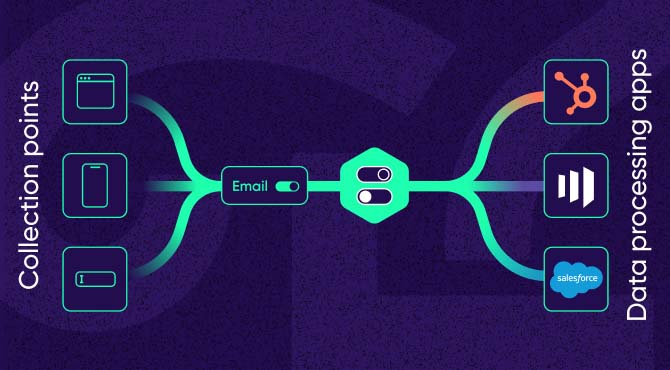
Let’s circle back to Consent Management Platforms, which play an increasingly important role in managing first-party data.
What is a CMP?
A Consent Management Platform is a tool that helps apps and websites manage user consent for data collection and use. They typically provide user-friendly interfaces for obtaining consent and a storage and management system for user consent preferences. Most CMPs integrate with various data collection and analytics tools as well.
Google maintains a list of certified CMPs if you’d like to take a look at what’s out there.
Why are CMPs more important now?
CMPs are becoming more attractive thanks to the stricter privacy regulations covered earlier in this guide, and the increased user awareness and concern about data privacy that exist today. Platform-level changes like Apple’s App Tracking Transparency have added an extra layer of complexity to the mix, as well.
On top of all of that, major ad platforms are now mandating the use of CMPs. For instance, Google has made it a requirement for apps that want to include their inventory with Google Ads—which includes most apps with ads. If developers don’t implement a CMP, Google automatically prompts their own consent interface on top of the app, potentially leading to a suboptimal user experience with double prompts. This shift in policy has made CMPs not just beneficial, but often necessary for app developers to maintain control over their user experience and ad integration.
What CMPs help apps with:
Well, they aim to address the pain caused by the above. CMPs provide brands with a streamlined consent collection process that is compliant with privacy regulations. They also include the added benefits of granular control over data collection based on user preferences and transparent data practices that can improve user trust.
When to use a CMP vs. Managing consent in-house:
If you aren’t sure whether using a CMP makes sense for you, here is a quick cheat sheet.
Consider using a CMP if:
- You want to include your inventory with Google Ads
- Your app operates in multiple jurisdictions with varying privacy laws
- You collect complex or extensive user data
- You lack in-house expertise in privacy regulations and consent management
- You want to save time and resources on developing a custom solution
Consider managing consent in-house when:
- Your app has simple data collection needs
- You have a small user base in a single jurisdiction
- You have strong in-house privacy and development expertise
- You require a highly customized consent management process
Final thoughts on keeping data clean
Clean data is actionable data. To keep it that way, invest in proper tooling for analysis and management and develop and maintain a robust taxonomy for consistency and usability. Be sure to regularly update and clean your data to maintain relevance and accuracy, keep your team aligned on data practices and usage, and consider implementing a Consent Management Platform to streamline compliance with privacy regulations.

Chapter 6
Using first-party data internally
So, you’ve mastered the art of first-party data collection. Ready to put it to use improving your product and marketing efforts? Let’s explore the various ways app developers and marketers can use first-party data internally to drive growth and enhance user experience.
Product development and improvement
For starters, your first-party data can be a game-changer when it comes to improving the experience for your users. Here are a few examples of how to apply learnings.
Driving analytics and generating insights
First-party data serves as the foundation for understanding user behavior and trends. By analyzing this data, product teams can identify patterns in user engagement, uncover pain points in the user journey, and recognize successful features and interactions.
These insights are crucial for informing product roadmaps and prioritizing development efforts.
Iterating and improving user experience
Along the same lines, all that user behavior can empower product teams to prioritize new feature development to meet user needs, identify features that need improvement or iteration, and make data-driven decisions about which features to sunset.
Remember, sometimes knowing which features to remove is as important as knowing which ones to add. All of these decisions can be influenced and assisted with the right data.
A/B testing
One of the core uses of first-party data is in A/B testing. This method allows teams across your organization to:
- Test variations of features, designs, or user flows
- Measure the impact of changes on key metrics like activation, retention, and monetization
- Make informed decisions based on statistically significant results
A/B testing, powered by first-party data, helps teams continuously drive better business performance with confidence.
That’s just the tip of the iceberg though, because product development isn’t the only place where first-party data can shine.
Marketing optimization
McKinsey & Company report that 76% of consumers become irritated when they receive ads and product recommendations that are not personalized. To relieve that irritation, marketers need to get more specific with their audiences.
Content personalization
First-party data enables sophisticated content personalization across the board. Offer tailored recommendations based on user preferences and past behaviors, create dynamic user experiences that adapt to individual needs, and move beyond one-size-fits-all solutions to provide unique, engaging experiences for each user that can boost their lifetime value.
Customer Relationship Management (CRM) and Lifecycle Marketing
Speaking of LTV, first-party data is the backbone of effective CRM and lifecycle marketing strategies. First-party data leads to better strategy which in turn fuels the engagement, retention, and monetization improvements that every marketer is working for.
- Advanced segmentation: Use the information to create more detailed user segments based on past and current behaviors, demographics, and user profiles and preferences.
- Customized communications: Tailor your messaging to users in push notifications, emails, and in-app messages.
- Timing and channel optimization: Use behavioral data to determine the best times and winning channels to engage with different user segments.
Cross-promotion between apps
Companies with multiple apps can use user IDs for vendors (IDFV) to enhance marketing impact across their different properties. For example, if a user plays two different games from a gaming company and that user has made a purchase in one but not the other, the company may want to build a campaign encouraging them to spend there as well.
Predictive analytics
While seeing the future isn’t possible yet, historical first-party data can be used to predict future user behavior. This involves identifying users at risk of churn, forecasting potential high-value users, and anticipating user needs and preferences.
Cross-functional benefits
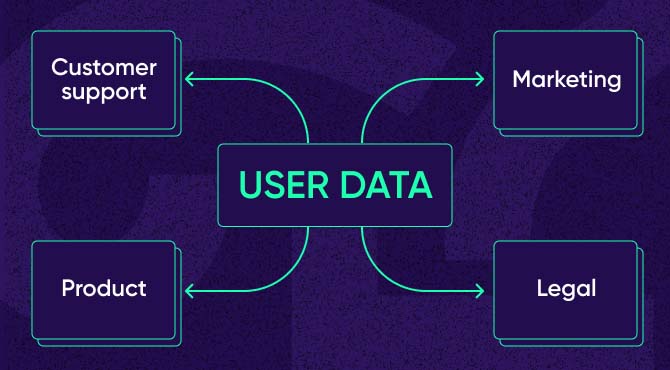
First-party data can also be used to foster stronger collaboration, both within your organization and also externally with customers.
Product-Marketing alignment
First-party data serves as a common language between product and marketing teams, helping them share insights about user behavior and preferences, align on key performance indicators (KPIs), and collaborate on feature development and marketing strategies
Better customer support
Using your data to provide support agents with user history and context can help any conversation go smoother. On top of that, your support team can anticipate user issues based on behavior patterns and offer proactive support for common pain points.
Key takeaways for internal usage
- First-party data is a powerful tool for both product development and marketing optimization.
- Use data to drive product decisions, from feature prioritization to personalization.
- Leverage advanced segmentation and personalization in your marketing efforts, too.
- Encourage cross-functional collaboration to maximize the value of your first-party data.
- Always prioritize user privacy and consent when using first-party data.

Chapter 7
Using first-party data externally
While first-party data is invaluable for internal use, privacy restrictions are creating a reality where it is also becoming invaluable for external use to enhance marketing efforts and partnerships. Partnering with retail media networks to run data collaboration campaigns can be quite lucrative, and this section explores how to collaborate with external partners while maintaining data compliance and security.
Compliance and consent
Before leveraging first-party data externally, it’s important to ensure specific consent was granted for external use, complying with legislation and platform rules. Then, you’ll want to verify that the use case was stated when the data was collected. Maintaining transparency with users about how their data will be used is vital to build trust.
In many places like the EU and Brazil, this is absolutely crucial. In other regions such as the US, a more lenient “opt-out” policy is enforced, allowing companies to collect data until the user explicitly asks them not to.
Custom audiences
The best way to make that first-party data work for you is to create highly segmented audiences. First, filter with specific behaviors like users who visited the paywall multiple times without subscribing or users who added specific products to their cart, then build your list with user IDs like IDFA, emails, or phone numbers.
How and where to use custom audiences
If you are looking for inspiration to start using custom audiences, check out these common examples:
- Exclusion lists:
- Prevent existing users from seeing new user acquisition communications
- Exclude paying subscribers from seasonal discount promotions
- Lookalike audiences (for new user acquisition):
- Create audiences of potential users based on your best existing profiles
- Available on platforms like Meta, TikTok, and Google
- Define source audiences, locations, and audience size
- Paid remarketing:
- Reach existing or lapsed users through external channels
- Balance audience relevance with size for optimal results
Mind your match rate
When building audiences, you need to keep your match rate in mind. In the context of first-party data, “match rate” refers to the percentage of user identifiers (such as email addresses or device IDs) from your first-party data that can be successfully matched with user profiles on an external platform or partner’s database. A higher match rate means more of your audience can be reached or targeted on that external platform. The cleaner and richer your data is, the higher you’ll be able to scale your match rate.
For example, imagine you have a list of 10,000 customer email addresses from your first-party data, and you want to run a targeted ad campaign on a social media platform. If the platform can match 7,000 of these email addresses to user profiles in its system, your match rate would be 70%. This means you can potentially reach 70% of your intended audience on that platform. High match rates can be reached even on iOS nowadays when combining consenting users, email, and phone numbers.
Commerce and retail media networks
The latest innovation in external first-party data usage is driven by commerce and retail media networks. McKinsey & Company report that 70% of advertisers have noted improved performance from retail media networks compared to other channels.
These powerful platforms represent a significant opportunity for both retailers and brands to maximize the value of their first-party data in a privacy-compliant manner.
What exactly are they?
Commerce media networks are essentially companies that monetize their first-party data by inviting brands to utilize it for targeted advertising and audience segmentation. These companies can range from retailers like Walmart or Best Buy, which create retail media networks (RMNs), to financial institutions, travel, transportation, and streaming services (to name just a few) that form commerce media networks (CMNs).
What makes them so attractive?
What makes these networks so attractive is that they have a treasure trove of first-party data they possess that is sourced directly from consumer interactions, such as shopping history, transaction data, account activity, content consumption, etc. This allows marketers to build segments that can be activated both onsite (within the retailer’s ecosystem) and offsite (on platforms like Meta or Google). With this data, marketers can create hyper-contextual and hyper-personalized campaigns that drive higher ROAS.
The massive growth opportunity
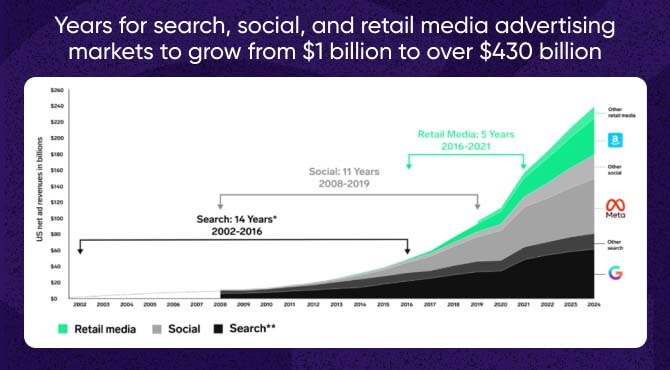
Retail media is experiencing explosive growth, with digital ad spend reaching over 20% and margins soaring to 50-70%. Predictions suggest it could attract up to $166 billion in ad spend by 2025, according to findings by eMarketer. This growth is driven by several factors:
- Signal loss mitigation: As third-party data becomes less available, and privacy restrictions hinder the sharing of data, these networks offer a valuable alternative.
- High margins: Retailers can potentially increase their margins from around 4% to as high as 70% by monetizing their data through these networks. This allows them to be highly flexible in their ability to maximize their clients’ ROAS.
- Diverse advertising opportunities: They allow for on-site, off-site, and in-store advertising, catering to retail, non-retail, and non-endemic advertisers.
The challenges to success
This booming industry is appealing but faces challenges when it comes to effective collaboration between brands and retail media networks. Let’s take a look at them and explore practical solutions to unlock the full potential of retail media partnerships.
Challenge 1: Walking the tightrope of privacy regulations
In an era of stringent data protection laws, balancing data utilization with compliance is not an easy task. Brands and networks must navigate complex regulations while still finding ways to extract valuable customer insights and successful campaigns.
Solution
To address these privacy concerns, the industry is turning to Privacy-Enhancing Technologies (PETs). A prime example is the data clean room.
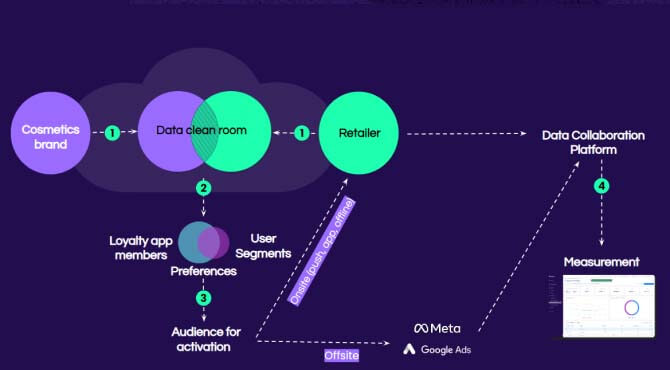
Data clean rooms are secure environments where multiple parties can analyze and combine their respective data sets without directly sharing raw data. They act as a neutral third party, allowing for valuable insights to be extracted while maintaining strict privacy controls.
Other important PETs include:
- K-anonymity: A method of data anonymization that prevents individual identification within a dataset.
- PII hashing: A technique that converts personally identifiable information into unreadable code for secure data handling.
- Differential privacy: A system for publicly sharing information about a dataset while withholding information about individuals.
Challenge 2: Managing trust while protecting proprietary data
Data is the lifeblood of modern marketing. Understandably, both brands and networks are hesitant to share their precious data assets, fearing misuse or competitive disadvantage.
Solution
To build trust and alleviate concerns, the industry must adopt rigorous privacy standards centered on the above Privacy-Enhancing Technologies (PETs).
But it isn’t just about the technology; cultivating trust through transparency is equally crucial. Companies should clearly communicate their data usage policies and security measures, being open about how shared data will be used and protected. This openness helps to build confidence among partners and users alike.
Challenge 3: Measurement mayhem, data silos, and the quest for standardization
Measurement offered by retail and commerce media networks often falls short – some don’t measure at all, some offer basic vanity metrics. But one thing is certain – there’s no standardization, and without consistent metrics across platforms, evaluating campaign performance becomes a guessing game. The lack of standardized measurement hinders meaningful comparisons and optimization efforts, not to mention all the fragmented data sources.
Solution
To overcome measurement challenges, it’s important to focus on transparency in measurement logic. This means clearly defining and sharing how metrics are calculated and interpreted, ensuring all stakeholders have a common understanding of performance indicators. Establishing a Single Source of Truth (SSOT) is crucial in this process. By creating a unified data repository, companies can power their omni-channel measurement strategies without the pitfalls of data duplication or inconsistencies.
Furthermore, implementing closed-loop omni-channel metrics is essential for a comprehensive view of campaign effectiveness. These systems allow businesses to measure the impact of all their commerce media campaigns on business outcomes, bridging the gap between online and offline interactions.
Challenge 4: The right tools to build the right audience
Many platforms lack sophisticated audience-building capabilities, limiting brands’ ability to create highly targeted segments for their campaigns.
Solution
It sounds simple, but the only way to do this successfully is by empowering your team with the tools they need. When it comes to building audiences that will perform well on commerce media networks, it’s important to have full SQL functionality for complex queries and user-friendly interfaces for non-technical users. Once the right audience is being used, the insights and results will follow.
The future of first-party data and commerce media
As we move into a future where first-party data becomes increasingly valuable, retail and commerce media networks represent a crucial opportunity for marketers. They allow for the continued use of first-party data for targeting, measurement, and optimization, all while maintaining privacy compliance and data security.
By advertising on these networks effectively, marketers can overcome signal loss challenges and create more targeted and effective advertising campaigns. The ability to measure the direct impact of these efforts while building stronger relationships with retail and commerce partners is the icing on the cake.
Conclusion
The future of marketing hinges on the ethical and strategic use of first-party data, which has become the cornerstone of effective campaigns and product development. As the digital landscape continues to evolve, with increasing emphasis on user privacy and data protection, the ability to collect, manage, and leverage first-party data will be a key differentiator for successful marketers.
By following the strategies and best practices outlined in this guide, marketers can:
- Build trust with users through transparent and compliant data practices
- Develop more personalized and engaging user experiences
- Create more effective and targeted marketing campaigns
- Make data-driven decisions to improve app performance and user satisfaction
As you implement these strategies, remember that the field of data management and privacy is constantly evolving. Stay informed about new regulations, technologies, and best practices to ensure your first-party data strategy remains effective and compliant in the long term.



